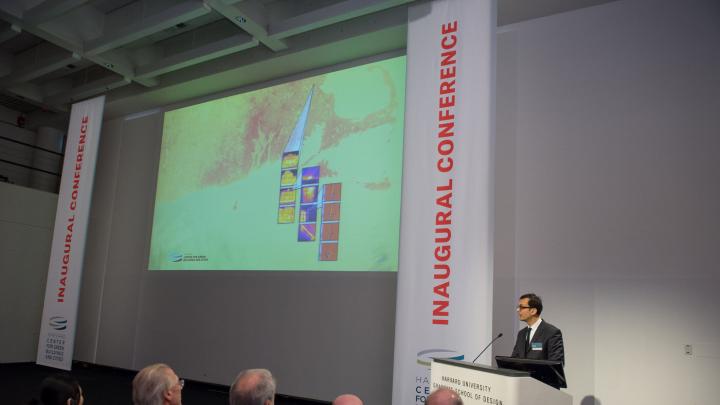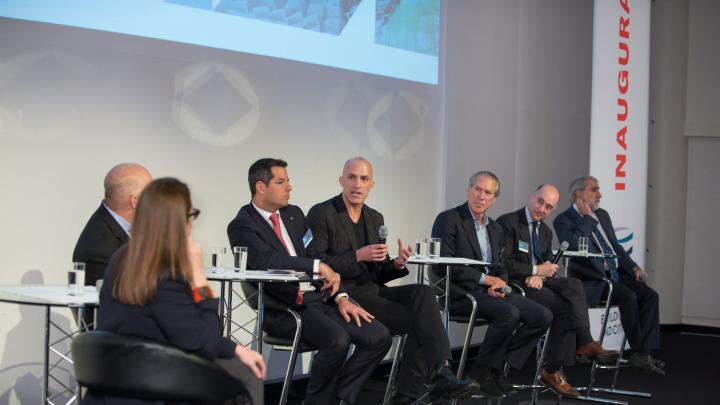The Harvard Center for Green Buildings and Cities (CBGC) held its inaugural Challenge Conference on Friday, bringing together leaders from industry and academia to discuss pressing questions for the fields of sustainability and design, ranging from why holistic mapping tools could help developers think on a more regional scale, to how to implement promising new solar technology. The conference helped delineate a wide-reaching research agenda for the new center, setting forth what professor of architectural technology Ali Malkawi, its founding director, called its “very ambitious” mission: to “rethink conventions of design practice and fundamentally shift the ways humans use energy in the long term.”
The day began with an acknowledgment of the enormity of the problems at hand. In his opening remarks, Williams professor of urban planning and design Jerold Kayden called climate change “the central issue—the existential issue—of our time.” Those who think about and create buildings and cities play a large role in these questions, because constructing, heating, cooling, and lighting the built environment consume huge portions of the world’s energy output. By bringing together interdisciplinary teams of engineers, designers, business leaders, and other potential stakeholders, CGBC can “show people how to make buildings and cities sustainable while spending less,” Malkawi said. “I believe that what is possible today is limited not by economics, politics, culture, costs, or material, but our imagining of what might be possible.”
The University announced the creation of CGBC last December as one of three initiatives supported by Evergrande Group, one of the largest real-estate developers in China. Members of Evergrande's management team, including founder and chairman Hui Ka Yan, were present for Friday’s festivities, helping to officially inaugurate the center after 11 months of preparatory work. University president Drew Faust opened the conference by reiterating her commitment to tackling climate change through intensive research (a call she has made repeatedly in campus debates over divestment from companies that produce fossil fuels). “Universities,” she said, “have a special obligation and accountability to the future, to the long view needed to anticipate and alter the trajectory of climate change.”
The center has set up more than a dozen long-term research projects in four areas: developing modeling techniques to better simulate and evaluate how buildings interact with their environment; creating high-performance construction materials and methods to eliminate waste; improving the economic incentives that influence the adoption of sustainable techniques; and studying what models and regulations could encourage sustainable planning on a regional and global scale. CGBC researchers also spent much of the summer conducting tests on the wood-frame house on Sumner Road that serves as the center’s offices. The center plans to use the building as a “living lab,” turning it into a net-positive energy producer while identifying some of the major obstacles to widespread adoption of retrofitting techniques. The team, Malkawi said in an interview before the event, has already identified major bottlenecks in the ability of existing models to optimize the small adjustments that can drastically reduce the energy consumption of an older structure.
Beyond this research, the pressing nature of climate change has pushed Malkawi and other leaders at the Graduate School of Design (GSD) to find ways to more immediately influence what’s happening in practice. Having looked to the field of public health as a model for closer ties between academia and the wider world, they brought outside practitioners, including four architects, in for Friday’s conference to help clarify which challenges in their own field they believe research at Harvard could help solve.
A major theme throughout the presentations was the need to debunk the idea that sustainability is separate from—and an added expense in—architecture and planning. “If [sustainability] is done properly and you consider it as an integral process, there is no additional expense for having a highly sustainable building,” explained Gordon Gill, M.Arch ’93, a founding partner of Adrian Smith + Gordon Gill Architecture. As evidence, he offered the 50-story office building his firm designed for the Federation of Korean Industries, which featured a unique exterior skin that integrated photovoltaic panels and helped reduce heating and cooling loads yet cost a third of what the client had originally projected. Architects, Gill said, are “now in a position to broaden our sphere of influence as designers” by integrating such sustainable solutions into their plans.
Friday’s presentations spoke to the breadth of the center’s design-driven mission. The two speakers from outside the design field focused on the technological and social challenges of sustainability in the developing world. Rockwood professor of energy Daniel Nocera presented his research on the “artificial leaf,” an inexpensive and lightweight photovoltaic material intended to store the energy of sunlight and turn individual houses into their own “power and gas stations.” Moving beyond the scope of the individual solar cell or house, Alejandro Murat—the CEO of Infonavit, the Mexican federal institute for workers’ housing and the country’s largest mortgage lender—spoke of the larger-scale planning challenges in the developing word. As the country faced a shortage in housing in the past decades, new homes were built with little regard to public resources like transportation, Murat said. Planners forgot that “houses aren’t islands,” ignoring the fact that dense and connected cities are key in improving sustainability and fighting inequality. “We need to have policies,” he said, “that are not efficient but are effective.”
Such efforts will require better tools to measure just how “effective” a given policy or technology will be. Several presenters spoke of the need for more sophisticated and consistent metrics, a major item on CGBC’s research agenda. In order to highlight the importance of networks and density in understanding the relationship between urbanism and sustainability, Joshua Prince-Ramus, M.Arch. ’96, a principal with the architecture firm REX, presented color-coded maps of Helsinki that showed how residents of different neighborhoods may be able to reach very different numbers of fellow citizens depending on transit access and local density. Like Murat, he offered something of a mea culpa for the shortsightedness of buildings and planners. “We as architects and planners and urban designers are myopically focused on energy conservation: the energy uses of buildings as well as their carbon footprint,” he said. “To my surprise, that’s only about a third of what we are responsible for.”
But even as CGBC broadens the tent of the design disciplines, presenters throughout the day reminded attendees that the traditional, humanistic concerns of architecture will remain an important part of creating dense and sustainable cities that people will actually want to live in. James Carpenter, the founder of James Carpenter Design Associates, spoke of his firm’s work with light and glass. Daylight, he explained, is a public resource, and one that will become ever more scarce as cities grow up. “Connection to nature will be more important as we build more densely,” he said.
The demand for the center’s titular green buildings and cities exists and is growing, explained Phil Harrison ’86, M.Arch. ’93, CEO of Perkins+Will, co-chair of the GSD’s capital campaign, and the final speaker of the day. Finding ways to measure impact, create new technologies, and think of architecture as deeply enmeshed in dense cities and regions will be key challenges for the new center. “The reason why we’re here today, and the reason why Evergrande is supporting the center, is because the demand for green buildings exceeds our ability to deliver green buildings,” he said. “What we have before us is extremely big and difficult.”









